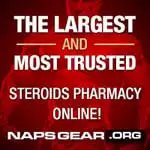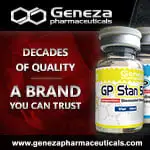holy ghost
New member
Relative Risk of Long-Term Oxandrolone Cycle
Q: How long can I stay on a low dose (25mg) of Anavar? I cannot find a correct legitimate answer anywhere! 6-8-10-12 weeks?? I know Anavar is used in treating AIDS patients from muscle wasting...so what is the max for "healthy" males and females?
A: In the context of this discussion, “maximum” and “risk” are going to be relative terms. It is really an individual decision as to what is acceptable and what is not. In the case of an HIV+ patient, preventing body wasting can be a life-saving treatment. The risks are, likewise, easy to weigh in light of the potential for death if treatment is not given. For a healthy individual, however, technically “no Anavar” would be the answer, as any substantial use will present some risks to the user. What you need to do is put these risks in perspective, and decide for yourself what is OK for you and what is not.
With Anavar, you are talking about a slightly to moderately liver toxic oral steroid with a pronounced effect on cholesterol balance (as all oral c-17 alkylated orals do). While liver toxicity is admittedly not as pronounced with this steroid as with many other orals, the risk for hepatic injury cannot be excluded, especially with long-term use. So in this regard, one should keep an eye on liver enzymes during use, especially during longer durations. The cholesterol issue is also a measurable one. For almost the entire time you are going to take the drug, you are likely to endure some fairly unfavorable lipid profiles. Your good (HDL) cholesterol levels will decline, and your bad (LDL) levels will likely increase. On the short term, this is highly unlikely to put you at serious cardiovascular risk, unless of course you have underlying cardiovascular disease. The longer you take the drug (total cumulative on-time), however, the longer the imbalanced cholesterol levels will be left to deposit plaque on your arteries. This doesn’t just instantly vanish once your levels return to normal (post cycle). As the months become years and the years become decades, the risks to your health are going to be greatly amplified. If you do one-day die early from heart disease, your death will be deemed just that too, “heard disease”. Steroids will never be blamed, even though they were a root-contributing factor.
OK, so I am jumping ahead here I know. Your question was much more narrow. You asked what was best, 6,8,10, or 12 week cycles. This is something I can’t really answer, as in all cases the acute (short-term) risks of use are going to be very low. I seriously doubt you would run into much trouble between weeks 6 or 12. The real issue, again, is the total cumulative time (in your life) you plan on using oral steroids like this. If this is something you are going to do 12 weeks every 6 months, or 24 weeks out of every year, you better take care! It is also important to remember that these risks are not isolated to orals. Increased cardiovascular disease risk is noted with esterified injectable steroids as well. It is just that these risks are significantly greater with the orals. With injectable drugs such as testosterone, nandrolone, boldenone, and methenolone, the impact the steroid will have on HDL/LDL is lighter. Also, there is often a “comfortable” range (usually 400mg per week give or take) where the cholesterol ratio is not excessively shifted, in many cases remaining in the boundaries of what is considered “normal”. Using injectable anabolic steroids like these (in reasonable doses) exclusively, and avoiding all orals, might pay dividends long-term with reducing the harm associated with these drugs.
Long-Term Androgen Replacement Therapy, Testicular Atrophy and Fertility
Q: I am a 38 y/o male, and I have hypogonadism. I have been taking either testosterone cypionate or enanthate for 8 years to treat the condition. My endocrinologist has had me on 400mg every 3 weeks with no time off, and it has "removed" my "boys". I live in a rural area of Alabama, and no other doctors here know anything about any of this. I can't afford to travel too far, but I'd like to be able to still have children if it isn't too late with the way I've been prescribed the testosterone IM's for so long. I need advice as to an HCG - human chorionic gonadotropin/testosterone regimen, hopefully to restore my "boys", and remain fertile. Basically, I need any suggestions on how to take these two together to stay fertile if it is not too late. Even if it is too late for fertility, I'd like to add the HCG anyway because of shrinkage and have my sack drop back, ;-)
A: Jim. Your complaints are not uncommon. These are the things you have to deal with very often with long-term androgen replacement therapy. You actually have two very common issues going on here that you want to address.
On the one hand is fertility. This is going to be an issue, as long-term testosterone administration generally reduces fertility. In fact, the drug is a fairly reliable as a male birth control option. This is due to the fact that you are flooding your blood with androgens from an outside source. This interrupts the normal hormone production cycle, a part of which involves the stimulation of spermatogenesis. If you want to have children, I suspect you are going to have to change your medical focus from androgen replacement to hormonal recovery and fertility. I know you had low androgen levels to begin with, but this doesn’t necessarily mean you are infertile, nor that normal hormone levels cannot be restored. In many cases a physician will initiate androgen as a fast way to alleviate the symptoms of low testosterone. Often an approach to endogenous (internal) hormonal recovery is still very viable. I would look into it.
Secondly, regardless of your state of fertility you would like advice on restoring “your boys” not normal size. Testicular atrophy, again, is a common side effect of androgen replacement therapy. This is also due to the hormonal disruption caused by exogenous testosterone, as I am sure you already know. For a long time, the advice had been to use HCG for only brief periods of time, usually isolated to the post-cycle window. This was done for fear that the drug may over stimulate the testes and cause desensitization to LH/HCG (interfering with recovery). Indeed, there is a great deal of support for this side effect of HCG use in the medical literature. More recently, however, successful protocols for the use of HCG regularly during hormone replacement therapy have been proposed. The most notable work in this area comes from Dr. John Crisler, who, after a long period of testing with pateints, had discovered that a low dose of HCG (250-350IU most commonly) twice per week could maintain testicular volume without desensitizing the cells to HCG. These protocols are now used by many testosterone recipients for dealing with the often very troubling cosmetic issue of testicular atrophy. I would point your physician to Dr. Crisler’s website for more information. An exact link to the HCG paper is below:
http://www.allthingsmale.com/word_docs/HCGupdate.doc
Trenbolone, Total Androgen Load and Cardiovascular Risk
Q: I am 56 years old, in great shape and very fit. After reading ANABOLICS 2006/7 I am very careful. I started a cycle of trenbolone enanthate. I chose this product because of the low risk and have done three cycles so far of eight weeks on and 16 weeks off. I have used this with a low dose of Testosterone topical gel daily. The gains were not as great as I would have liked, but I have managed to keep much of gains between cycles. I used 1-2cc's per dose weekly. I have two questions. Could I safely stack another product with this to increase my gains? If trenbolone enanthate becomes difficult for me to obtain, what would you recommend I use instead bearing in my mind my low risk preference but desire to see results? I should add I have had tests done after each cycle and the results were all fine.
A: I am certainly glad to hear that my books have had some impact on your preference for safety. As you clearly understand, these drugs are not without risk. At the same time, however, these risks can be reduced with a little bit of care and forethought. I think this is an understanding that all (steroid user or not) should have. You asked a couple of questions pertaining to safety, so I will first address your concern about adding another drug to your stack. Here, you need to keep in mind that the total weekly dose is going to be a key factor in dictating risk, even if you are elevating the dose with a fairly safe drug. The mildest drugs, which probably include testosterone and nandrolone, can still dramatically shift the cholesterol balance if a sufficient dose is taken. So if you are presently in a low-dose range with trenbolone and finding it “not too harsh” on your lipids, care should be taken as a new drug is added, as it may easily push you to a zone where cardiovascular disease risk (assessed by HDL/LDL balance) is significantly increased.
Next, you asked about a replacement for trenbolone. This is perhaps not the worst idea even if it is still available to you. While trenbolone may be far from the worst steroid, it is not quite the safest either. While it does lack significant liver toxicity and may be weaker on your lipids than many orals, it remains extremely potent and readily capable of increasing risk factors for cardiovascular disease. In addition to being very strong, trenbolone is also non-aromatizable. This means that androgen to estrogen activity is going to shift in favor of the former even more profoundly than it would otherwise. This is important because estrogen helps to mitigate some of the negative health effects of elevated androgen levels. Studies with testosterone, for example, have shown that the drug can have a significantly greater negative impact on lipids if the hormone is taken with an aromatase inhibitor compared to without. Trenbolone is, for lack of a better example, like taking a strong dose of testosterone combined with an aromatase inhibitor. Not the most ideal situation for your lipids, obviously. Safer non-methylated injectable drugs would probably include testosterone, nandrolone, boldenone, and methenolone. Given a dose of equivalent potency, an injectable testosterone is perhaps the safest of all anabolic/androgenic steroids; at least as far as cardiovascular disease risk is concerned.
Q: How long can I stay on a low dose (25mg) of Anavar? I cannot find a correct legitimate answer anywhere! 6-8-10-12 weeks?? I know Anavar is used in treating AIDS patients from muscle wasting...so what is the max for "healthy" males and females?
A: In the context of this discussion, “maximum” and “risk” are going to be relative terms. It is really an individual decision as to what is acceptable and what is not. In the case of an HIV+ patient, preventing body wasting can be a life-saving treatment. The risks are, likewise, easy to weigh in light of the potential for death if treatment is not given. For a healthy individual, however, technically “no Anavar” would be the answer, as any substantial use will present some risks to the user. What you need to do is put these risks in perspective, and decide for yourself what is OK for you and what is not.
With Anavar, you are talking about a slightly to moderately liver toxic oral steroid with a pronounced effect on cholesterol balance (as all oral c-17 alkylated orals do). While liver toxicity is admittedly not as pronounced with this steroid as with many other orals, the risk for hepatic injury cannot be excluded, especially with long-term use. So in this regard, one should keep an eye on liver enzymes during use, especially during longer durations. The cholesterol issue is also a measurable one. For almost the entire time you are going to take the drug, you are likely to endure some fairly unfavorable lipid profiles. Your good (HDL) cholesterol levels will decline, and your bad (LDL) levels will likely increase. On the short term, this is highly unlikely to put you at serious cardiovascular risk, unless of course you have underlying cardiovascular disease. The longer you take the drug (total cumulative on-time), however, the longer the imbalanced cholesterol levels will be left to deposit plaque on your arteries. This doesn’t just instantly vanish once your levels return to normal (post cycle). As the months become years and the years become decades, the risks to your health are going to be greatly amplified. If you do one-day die early from heart disease, your death will be deemed just that too, “heard disease”. Steroids will never be blamed, even though they were a root-contributing factor.
OK, so I am jumping ahead here I know. Your question was much more narrow. You asked what was best, 6,8,10, or 12 week cycles. This is something I can’t really answer, as in all cases the acute (short-term) risks of use are going to be very low. I seriously doubt you would run into much trouble between weeks 6 or 12. The real issue, again, is the total cumulative time (in your life) you plan on using oral steroids like this. If this is something you are going to do 12 weeks every 6 months, or 24 weeks out of every year, you better take care! It is also important to remember that these risks are not isolated to orals. Increased cardiovascular disease risk is noted with esterified injectable steroids as well. It is just that these risks are significantly greater with the orals. With injectable drugs such as testosterone, nandrolone, boldenone, and methenolone, the impact the steroid will have on HDL/LDL is lighter. Also, there is often a “comfortable” range (usually 400mg per week give or take) where the cholesterol ratio is not excessively shifted, in many cases remaining in the boundaries of what is considered “normal”. Using injectable anabolic steroids like these (in reasonable doses) exclusively, and avoiding all orals, might pay dividends long-term with reducing the harm associated with these drugs.
Long-Term Androgen Replacement Therapy, Testicular Atrophy and Fertility
Q: I am a 38 y/o male, and I have hypogonadism. I have been taking either testosterone cypionate or enanthate for 8 years to treat the condition. My endocrinologist has had me on 400mg every 3 weeks with no time off, and it has "removed" my "boys". I live in a rural area of Alabama, and no other doctors here know anything about any of this. I can't afford to travel too far, but I'd like to be able to still have children if it isn't too late with the way I've been prescribed the testosterone IM's for so long. I need advice as to an HCG - human chorionic gonadotropin/testosterone regimen, hopefully to restore my "boys", and remain fertile. Basically, I need any suggestions on how to take these two together to stay fertile if it is not too late. Even if it is too late for fertility, I'd like to add the HCG anyway because of shrinkage and have my sack drop back, ;-)
A: Jim. Your complaints are not uncommon. These are the things you have to deal with very often with long-term androgen replacement therapy. You actually have two very common issues going on here that you want to address.
On the one hand is fertility. This is going to be an issue, as long-term testosterone administration generally reduces fertility. In fact, the drug is a fairly reliable as a male birth control option. This is due to the fact that you are flooding your blood with androgens from an outside source. This interrupts the normal hormone production cycle, a part of which involves the stimulation of spermatogenesis. If you want to have children, I suspect you are going to have to change your medical focus from androgen replacement to hormonal recovery and fertility. I know you had low androgen levels to begin with, but this doesn’t necessarily mean you are infertile, nor that normal hormone levels cannot be restored. In many cases a physician will initiate androgen as a fast way to alleviate the symptoms of low testosterone. Often an approach to endogenous (internal) hormonal recovery is still very viable. I would look into it.
Secondly, regardless of your state of fertility you would like advice on restoring “your boys” not normal size. Testicular atrophy, again, is a common side effect of androgen replacement therapy. This is also due to the hormonal disruption caused by exogenous testosterone, as I am sure you already know. For a long time, the advice had been to use HCG for only brief periods of time, usually isolated to the post-cycle window. This was done for fear that the drug may over stimulate the testes and cause desensitization to LH/HCG (interfering with recovery). Indeed, there is a great deal of support for this side effect of HCG use in the medical literature. More recently, however, successful protocols for the use of HCG regularly during hormone replacement therapy have been proposed. The most notable work in this area comes from Dr. John Crisler, who, after a long period of testing with pateints, had discovered that a low dose of HCG (250-350IU most commonly) twice per week could maintain testicular volume without desensitizing the cells to HCG. These protocols are now used by many testosterone recipients for dealing with the often very troubling cosmetic issue of testicular atrophy. I would point your physician to Dr. Crisler’s website for more information. An exact link to the HCG paper is below:
http://www.allthingsmale.com/word_docs/HCGupdate.doc
Trenbolone, Total Androgen Load and Cardiovascular Risk
Q: I am 56 years old, in great shape and very fit. After reading ANABOLICS 2006/7 I am very careful. I started a cycle of trenbolone enanthate. I chose this product because of the low risk and have done three cycles so far of eight weeks on and 16 weeks off. I have used this with a low dose of Testosterone topical gel daily. The gains were not as great as I would have liked, but I have managed to keep much of gains between cycles. I used 1-2cc's per dose weekly. I have two questions. Could I safely stack another product with this to increase my gains? If trenbolone enanthate becomes difficult for me to obtain, what would you recommend I use instead bearing in my mind my low risk preference but desire to see results? I should add I have had tests done after each cycle and the results were all fine.
A: I am certainly glad to hear that my books have had some impact on your preference for safety. As you clearly understand, these drugs are not without risk. At the same time, however, these risks can be reduced with a little bit of care and forethought. I think this is an understanding that all (steroid user or not) should have. You asked a couple of questions pertaining to safety, so I will first address your concern about adding another drug to your stack. Here, you need to keep in mind that the total weekly dose is going to be a key factor in dictating risk, even if you are elevating the dose with a fairly safe drug. The mildest drugs, which probably include testosterone and nandrolone, can still dramatically shift the cholesterol balance if a sufficient dose is taken. So if you are presently in a low-dose range with trenbolone and finding it “not too harsh” on your lipids, care should be taken as a new drug is added, as it may easily push you to a zone where cardiovascular disease risk (assessed by HDL/LDL balance) is significantly increased.
Next, you asked about a replacement for trenbolone. This is perhaps not the worst idea even if it is still available to you. While trenbolone may be far from the worst steroid, it is not quite the safest either. While it does lack significant liver toxicity and may be weaker on your lipids than many orals, it remains extremely potent and readily capable of increasing risk factors for cardiovascular disease. In addition to being very strong, trenbolone is also non-aromatizable. This means that androgen to estrogen activity is going to shift in favor of the former even more profoundly than it would otherwise. This is important because estrogen helps to mitigate some of the negative health effects of elevated androgen levels. Studies with testosterone, for example, have shown that the drug can have a significantly greater negative impact on lipids if the hormone is taken with an aromatase inhibitor compared to without. Trenbolone is, for lack of a better example, like taking a strong dose of testosterone combined with an aromatase inhibitor. Not the most ideal situation for your lipids, obviously. Safer non-methylated injectable drugs would probably include testosterone, nandrolone, boldenone, and methenolone. Given a dose of equivalent potency, an injectable testosterone is perhaps the safest of all anabolic/androgenic steroids; at least as far as cardiovascular disease risk is concerned.


 Please Scroll Down to See Forums Below
Please Scroll Down to See Forums Below 










